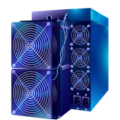IceRiver KS1
KS1 profitability insights powered by real-time data: Discover how much your KS1 can earn using our advanced ASIC miner calculator. We use live mining reward data and automatically factor in electricity costs, giving you a clear overview of your potential daily, monthly, and yearly returns.
Profitability Analysis
Here you can see a detailed analysis of miner profitability, updated in real-time.
| Period | Income | Expense | Profit |
|---|---|---|---|
|
Daily
|
$0.26 | $1.15 |
$-0.89
|
|
Monthly
|
$7.86 | $34.56 |
$-26.70
|
|
Yearly
|
$95.63 | $420.48 |
$-324.85
|
About the IceRiver KS1 (1TH/s)
Learn more about this ASIC miner, including its specifications, performance, energy consumption, and profitability.
With an air of quiet competence, the IceRiver KS1 proves itself a focused instrument for Kaspa’s kHeavyHash, delivering up to 1 terahash per second at roughly 600 watts-an efficiency of about 0.6 joules per gigahash-so that, really, one could scarcely doubt its suitability for sustained, economical operation when treated with proper care; the unit’s advanced cooling holds temperatures steady during long runs, while refined power management tempers load fluctuations to keep hashrate consistent, and secure firmware with low‑latency data handling supports reliable share submission; compact enough at about 370×195×290 millimeters and near 12.5 kilograms, it slots neatly into varied racks or shelves, though the 75‑decibel noise profile advises a dedicated, ventilated location rather than a shared living space, and it performs best between 0 and 35 degrees Celsius, an ambient sweet spot any prudent operator would preserve with generous, front‑to‑back airflow and regular dust control; Ethernet connectivity ensures stable links to pools, which is plainly preferable to wireless for minimizing latency and stales, and one must, if one is sensible, change default credentials and place the miner on a segmented network for peace of mind; our profit calculator helps estimate outcomes by accounting for electricity rates, pool fees, uptime, network difficulty, block rewards, and the inevitable drift of difficulty over time-run a few scenarios, she would say, and you will know your threshold for viability-and in day‑to‑day practice, monitoring the dashboard for temperatures, fan speeds, and rejected share rates, keeping cables tidy with ample electrical headroom, and scheduling occasional cleanings will preserve efficiency; it is also wise to ensure steady ambient conditions, avoid restrictive enclosures that starve intake or exhaust, maintain a clear intake path, and, should the miner be housed with others, observe consistent labeling and IP management to simplify pool changes and firmware updates, for nothing contributes more to predictable returns than unromantic uptime and the quiet assurance-so very welcome-that the KS1 will do exactly as intended hour after hour.
Discover Which Coins This Miner Can Mine
Explore the cryptocurrencies that can be mined using IceRiver KS1 (1TH/s), including detailed profitability.
Currency Converter
Calculate the mineable coins to any currency.
| Coin | Income/Day | Profit/Day |
|---|---|---|
|
$0.26
$
0.00000258

|
$-0.89
$
-0.00000876

|
|
|
$0.27
$
5.49

|
$-0.89
$
-18.34914216

|
|
|
$0.13
$
26,727.01

|
$-1.02
$
-203,996.00619261

|
Historical Mining Performance
View the performance trends of IceRiver KS1 (1TH/s) over weekly, monthly, and yearly timeframes.
Historical Profitability
View the historical income and profit trends for this miner.
KHeavyHash Miner Generations
Evolution of cryptocurrency mining hardware throughout the years, with the current generation highlighted for reference.
Generation 1
3 minersGeneration 2
3 minersGeneration 3
3 minersGeneration 4
3 minersGeneration 5
3 minersGeneration 6
4 minersGeneration 7
4 minersMore Information about the
Learn more about the IceRiver KS1 (1TH/s)
On the dashboard you start with the ending: a calm, unblinking 1 terahash per second on Kaspa’s kHeavyHash while the meter hovers near 600 watts-about 0.6 joules per gigahash-and shares land promptly with low rejects; rewind a step and the explanation surfaces in the execution pipeline, trimmed to avoid redundant passes and tuned for tight instruction flows that keep latency down, then further back to a hardened, Linux-based control board whose secure stack pairs with custom firmware, allowing operators to dial power targets and fan behavior to match changing network difficulty or ambient conditions without sacrificing stability; reverse again into the chassis where a specialized PCB routes low-latency interconnects between compute elements to minimize contention, and a reinforced power delivery stage smooths transients so voltage sag doesn’t nibble at performance over long runs; earlier still, the proprietary cooling design-focused airflow, efficient heat transfer paths, and intelligent thermal dissipation-keeps components within a safe envelope so the hashrate doesn’t drift as temperatures climb; come out to the room and the physical facts assert themselves: a compact 370×195×290 millimeters and about 12.5 kilograms make it practical to place on shelves or in small racks, though its approximately 75‑decibel voice argues for a ventilated, non-residential space, ideally with front‑to‑back airflow maintained and dust kept at bay; Ethernet is the intended tether, preferred for latency and stability, and it pays to assign a static address or reserved lease, change default credentials, segment the miner on a VLAN, and restrict inbound management ports through your firewall to reduce attack surface; plan power with headroom for startup draw and fan ramping, use quality cabling and surge protection, and avoid daisy-chaining strips that invite voltage drop; in routine operation, keep ambient between 0 and 35 degrees Celsius, monitor temperatures, fan speeds, and rejected share rates, set pool failovers to preempt outages, and schedule occasional cleanings so fins and intakes breathe freely; because the KS1 is an application-specific machine aimed squarely at Kaspa, the payoff is predictability-fewer variables to babysit-provided the basics are honored: steady power, clean air, sensible network hygiene, timely firmware updates, and an eye on logs for early signs of trouble, all conspiring so that the end result-the very thing you saw at the start-stays as it is hour after hour.
Where to Buy?
Trusted vendors and current market availability, showcasing verified suppliers offering this ASIC miner along with their latest pricing and stock information.
No Offers Available
There are currently no offers for this miner. Please check back later.
Technical Specifications
Detailed hardware specifications and mining capabilities for IceRiver KS1
Basic Information
Performance
Physical Dimensions
Mineable Cryptocurrencies


Algorithm Information: KHeavyHash
Learn more about the KHeavyHash algorithm and how it works.
KHeavyHash is a cryptographic hash function that serves as the backbone of Kaspa proof-of-work consensus mechanism. This algorithm processes input data of any length and produces a fixed hash value, ensuring security and integrity in the mining process.
Crypto Mining Pools
Connect to the most reliable mining pools and maximize your crypto mining efficiency with optimized uptime and profitability.
User Reviews
See what users are saying about this miner.
No Reviews Yet
Be the first to review this miner!
Frequently Asked Questions
Everything you need to know about the IceRiver KS1
How efficient is the IceRiver KS1 1TH/s?
What are the electricity costs for the IceRiver KS1 1TH/s (USD)?
How much power does the IceRiver KS1 1TH/s use?
Who manufactures the KS1?
What is the hashrate of the IceRiver KS1?
Which cryptocurrencies can be mined with the IceRiver KS1 1TH/s?
 NiceHash (BTC)
NiceHash (BTC)
 Kaspa (KAS)
Kaspa (KAS)
 Sedra (SDR)
Sedra (SDR)
 English
English
 German
German
 Hungarian
Hungarian
 Dutch
Dutch
 Spanish
Spanish
 French
French
 Italian
Italian
 Czech
Czech
 Polish
Polish
 Greek
Greek

















